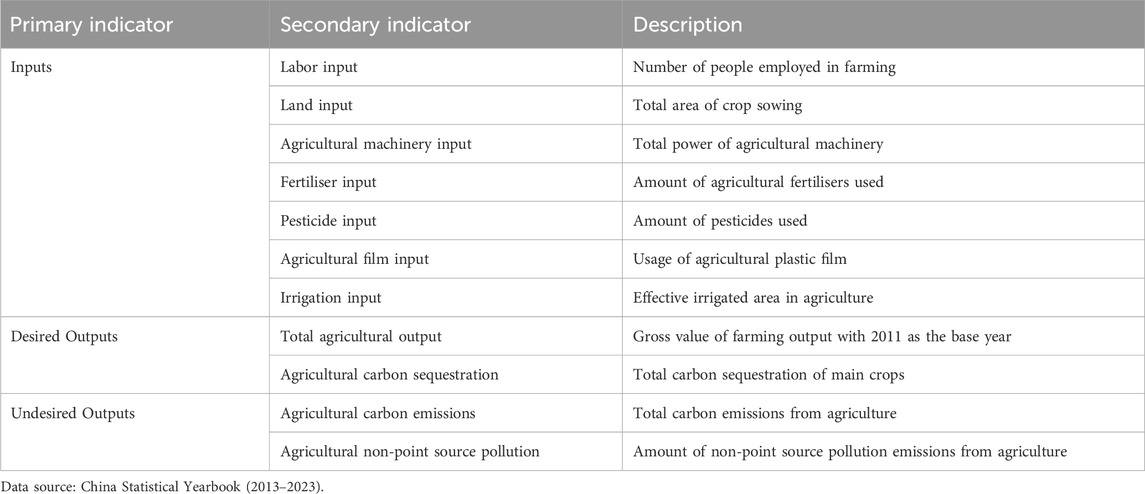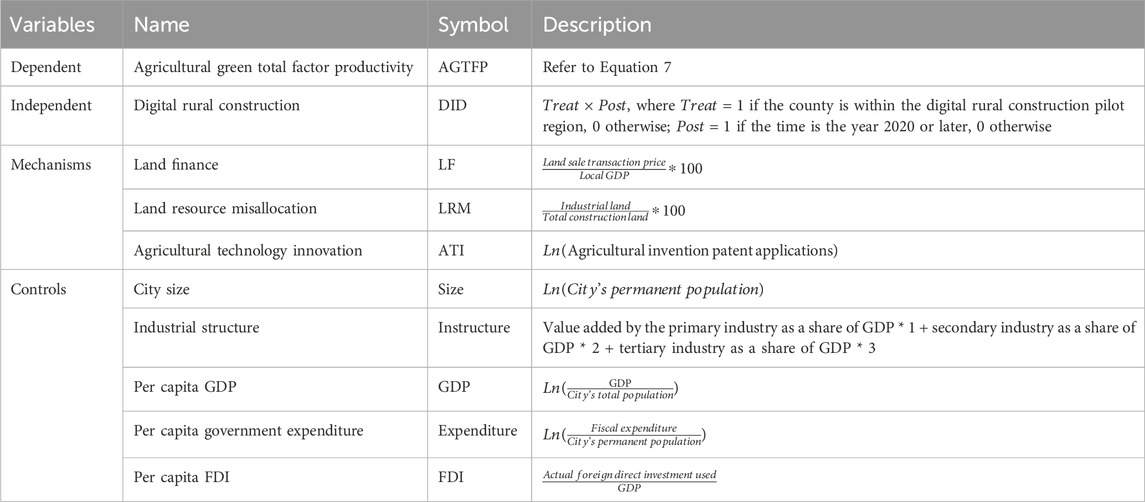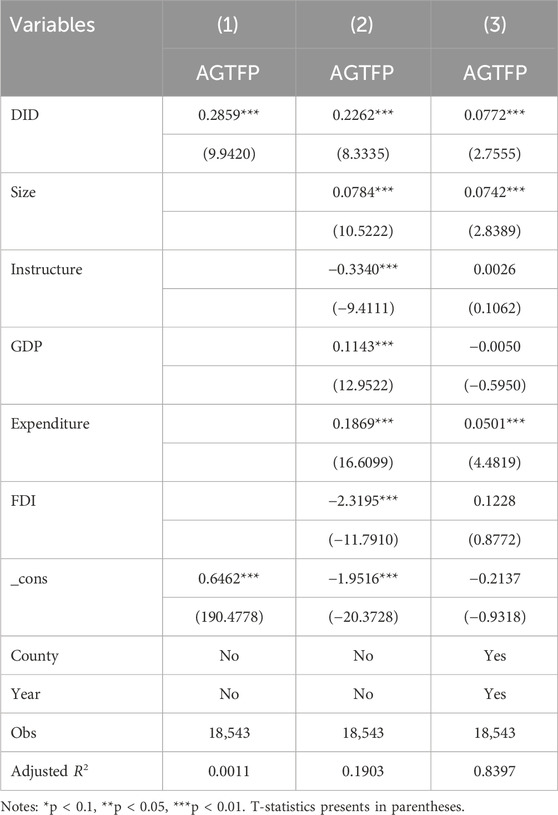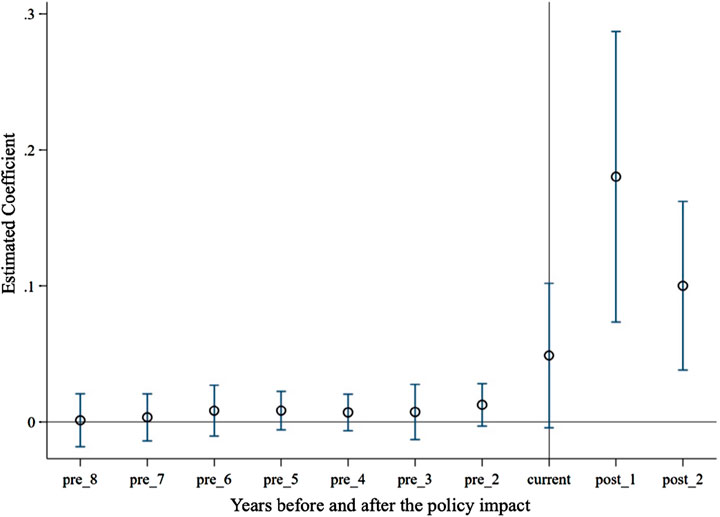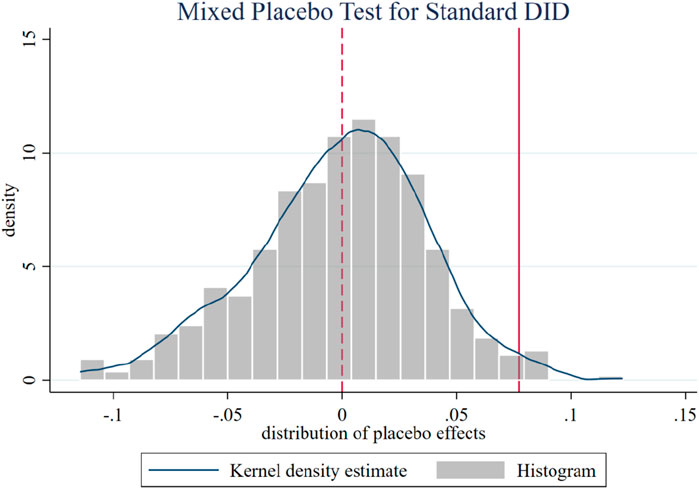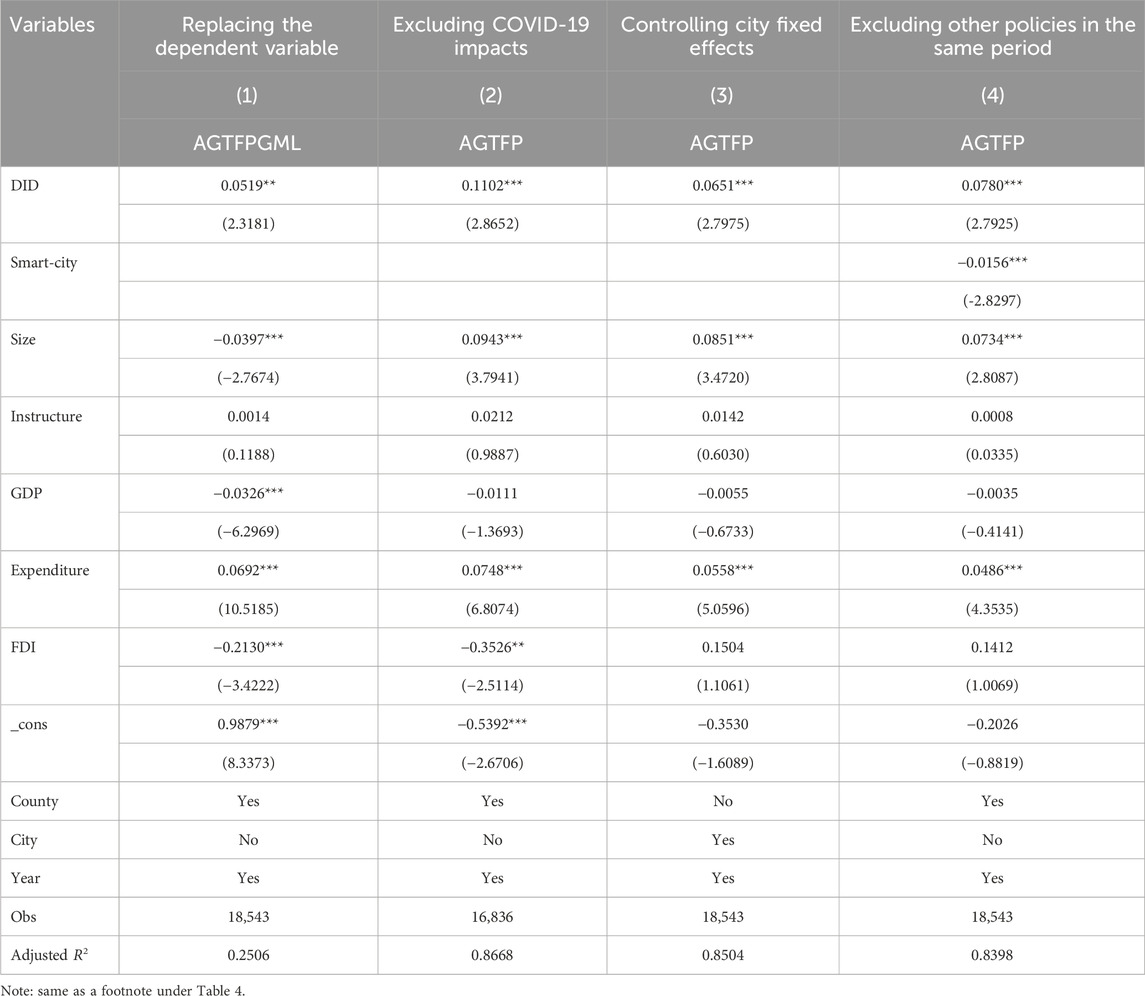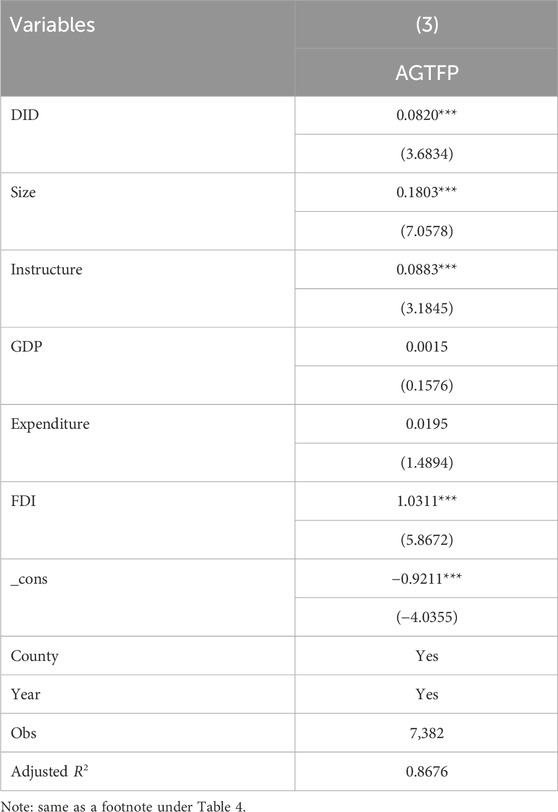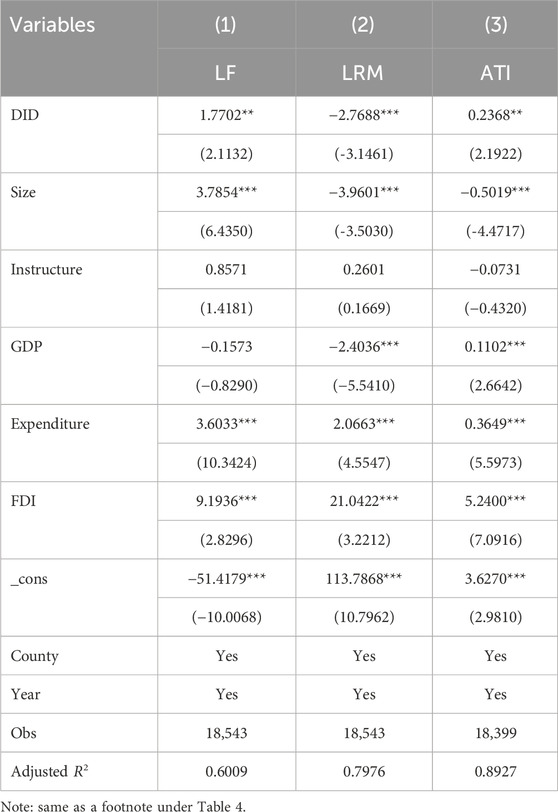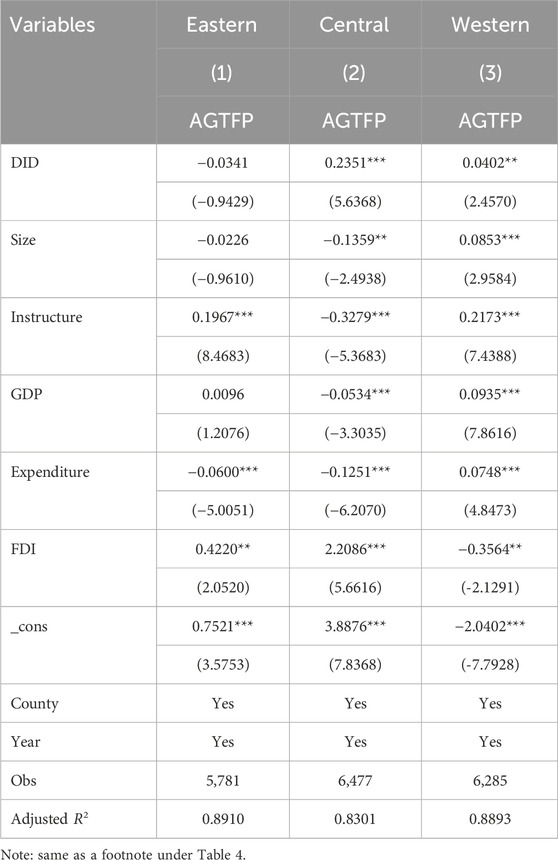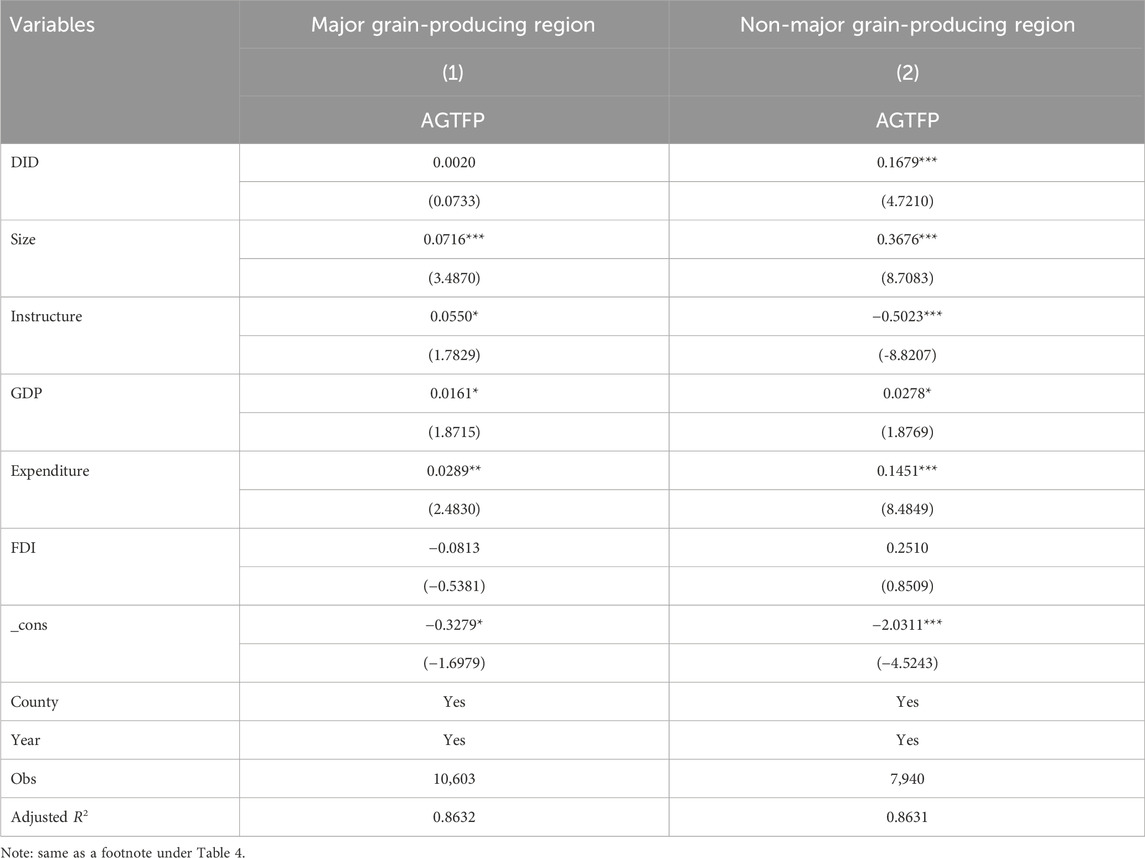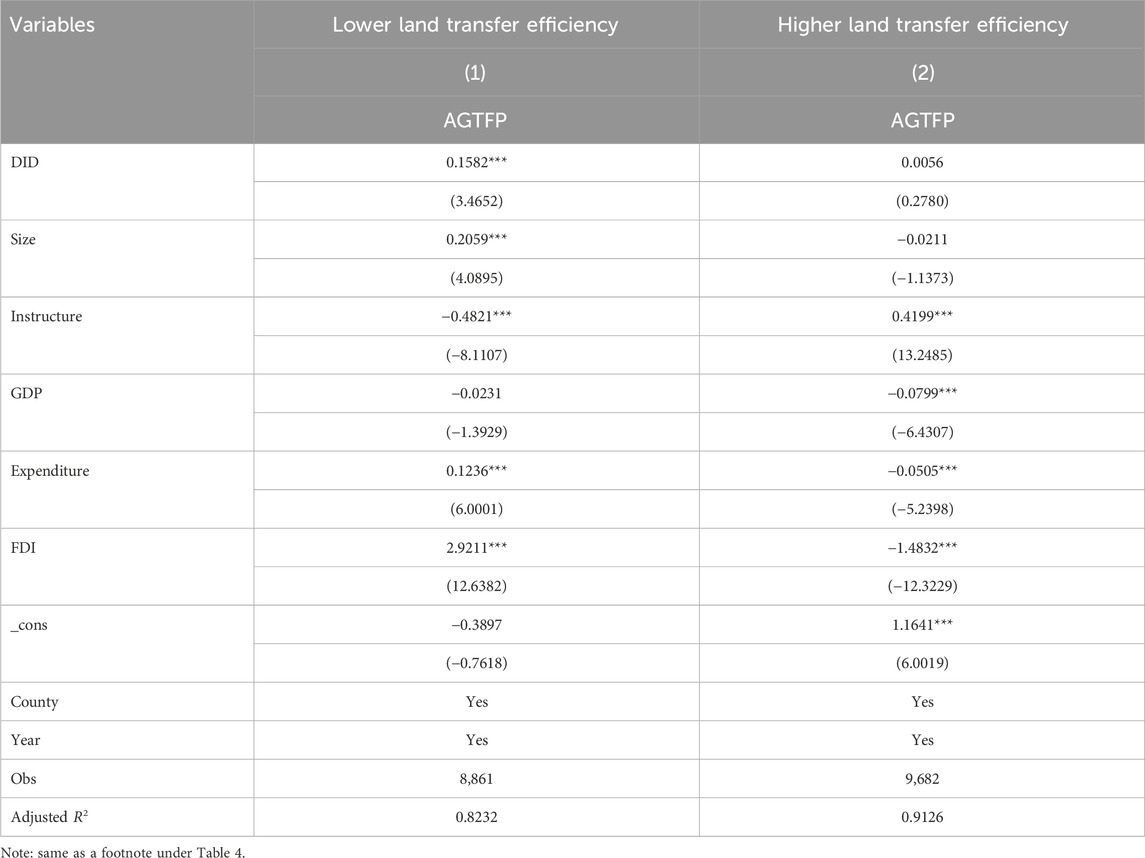- 1Department of Law, Dongguk University, Seoul, Republic of Korea
- 2School of Humanities and Law, Nanchang Hangkong University, Nanchang, China
- 3Department of Business Administration, Jeonbuk National University, Jeonju, Republic of Korea
Prior studies on whether and how digital rural construction (DRC) contributes to enhancing agricultural green total factor productivity (AGTFP) remain limited. This study uses Difference-in-Differences method and panel data comprising 18,543 observations from 2,128 counties (districts) between 2012 and 2022 to examine the impact of DRC on AGTFP and its underlying mechanisms. The findings indicate that DRC significantly boosts AGTFP, a result that holds after conducting several robustness checks and endogeneity test, including replacing the dependent variable, excluding other policy impacts, adjusting the sample period, and propensity score matching method. The mechanisms through which DRC enhances AGTFP include improving land finance, alleviating land resource misallocation, and fostering agricultural technology innovation. The effects of DRC on AGTFP are notably more pronounced in the central and western regions of China, non-major grain-producing areas, and regions with lower land transfer efficiency. Our insights clarify the influence pathways through which DRC facilitates the enhancement of AGTFP, offering fresh theoretical insights and practical implications for further guiding DRC and leveraging the efficiency of AGTFP.
1 Introduction
Agricultural green total factor productivity (AGTFP) is defined as the production efficiency in agriculture under resource and environmental constraints, aiming to enhance economic efficiency while reducing environmental impacts (Wang X. et al., 2024). Such a focus underscores the essential principles of sustainable agricultural progress (Chu et al., 2024; Jiang et al., 2024; Xu et al., 2025). Historically, constrained by various factors, the development of agriculture in China has faced bottlenecks such as low production efficiency, economic benefits, and significant ecological and environmental pressures (Hu et al., 2024). It is imperative to pinpoint new focal points that leverage digital elements and technological innovation to empower agriculture, promoting a transformation towards intensive, efficient, and greener high-quality development. Recently, the swift proliferation of the internet and smartphones, along with the expansion of e-commerce channels, has laid a solid foundation for digital rural construction (DRC) (Wu and Liu, 2025). DRC is defined as the acceleration of information infrastructure construction in rural areas, the integration of information technology into rural production and life, the promotion of applications such as remote education and telemedicine, and the establishment of a digital governance system for rural areas.1 As a confluence point of a network powerhouse, digital China, and the rural revitalization strategy, DRC has garnered substantial attention from the Chinese government. The 2018 Central No. 1 Document proposed the implementation of a digital rural strategy, marking a new stage of comprehensive enhancement in the informatization construction of China’s agriculture and rural areas. In 2019, the General Office of the Communist Party of China Central Committee and the State Council issued the “Digital Rural Development Strategy Outline,”2 which clearly outlined a comprehensive plan for DRC, providing more robust support for rural digital development. In 2020, the Central Cyberspace Affairs Commission, in collaboration with seven other agencies, released the “Notice on Conducting National Digital Rural Pilot Work,” followed by the announcement of the “National Digital Rural Pilot Regions List,” which designated 117 counties (cities, districts) as the inaugural group of national digital rural pilot areas.3 Despite these policy documents closely following the new changes faced by the informatization development of China’s agriculture and rural areas and playing a guiding role, whether DRC can act as a catalyst for enhancing AGTFP remains an issue to be explored.
The academic consensus currently underscores multiple critical viewpoints: First, the digital economy enhances agricultural production efficiency and transforms agricultural growth modes by providing platform technologies, thereby influencing agricultural development patterns (Fabregas et al., 2019; Hu et al., 2024; Ye, 2025). Second, digital rural initiatives utilize digital technologies as the most significant variable to improve agricultural economic benefits and as a new form of productive power in agricultural industry development (Li et al., 2025; Wang and Tang, 2023). These technologies optimize resource allocation and integration, leading to creative destruction and disruptive innovation in traditional agriculture (Zhao Li et al., 2024), thus constructing an intensive, efficient, and green modern agricultural industry. Third, digital technologies exert strong spillover effects and empowering functions on resources, industries, and agricultural entities (Du et al., 2023; Subramanian, 2021). This influence optimizes the rural labor structure, enhances the technological content within agriculture, transforms agricultural production modes (Li et al., 2023; Musajan et al., 2024), and stimulates the endogenous development momentum of agriculture, which significantly enhances agricultural modernization. Fourth, digital technologies reduce the costs for farmers to access goods and market information (De la Peña and Granados, 2024), thereby improving farmers’ abilities to connect with markets (Sarku and Ayamga, 2025). Additionally, these technologies enhance the level of rural human capital and drive the upgrading of the agricultural industry (Liu B. et al., 2023; Zhao Liyang et al., 2024).
However, limited research has directly explored the impact of DRC on AGTFP (Cai and Han, 2024; Lu et al., 2024; Xu et al., 2025), leaving open the question of whether DRC can significantly enhance AGTFP. Moreover, given the relatively recent introduction of DRC, the transmission mechanisms through which it influences AGTFP remain unclear. Additionally, the potential heterogeneous effects of DRC on AGTFP have been underexamined. Addressing the identified research gaps, this study recommends these RQs:
RQ1: Does DRC enhance AGTFP?
RQ2: What is the impact mechanism of DRC on AGTFP?
RQ3: Does the impact of DRC on AGTFP exhibit potential heterogeneity?
The answers to these questions could provide decision-making insights for effectively unleashing the potential of DRC, fostering the economic upgrading of agriculture, and creating a new engine for high-quality agricultural development. In our study, we treat the DRC pilot policy as a quasi-natural experiment and empirically evaluate the impact of the implementation of DRC on AGTFP using a panel data set of 2,128 counties (districts) from 2012 to 2022. We employ a Difference-in-Differences (DID) model to assess the effects and their underlying mechanisms. Our findings confirm that DRC significantly enhances AGTFP. Robustness checks further validate the reliability of our results. Additionally, we identify three mediating mechanisms through which DRC impacts AGTFP: land finance, land resource misallocation, and agricultural technology innovation. Our analysis reveals that DRC improves levels of land finance and agricultural technology innovation, and reduces land resource misallocation, all of which contribute to the enhancement of AGTFP. Finally, we observe significant heterogeneity in the impact of DRC on enhancing AGTFP in agriculture across different geographic locations, grain functional areas, and land transfer efficiency. This impact is stronger in central and western China, non-grain-producing areas, and regions with lower land transfer efficiency.
This study extends the marginal contributions in three significant areas: First, it empirically investigates the influence of DRC on AGTFP at the level of Chinese county and district, enriching the quantitative research on how DRC influences high-quality agricultural development. Second, the study delineates the transmission mechanisms through which DRC enhances AGTFP, focusing on land finance, land resource misallocation, and agricultural technology innovation. This analysis provides empirical support and policy guidance for optimizing DRC policies and advancing high-quality agricultural growth. Third, we discuss the DRC’s diverse impacts on AGTFP by geographical location and grain functional areas, this research offers experiential evidence for coordinated regional agricultural development.
This study is organized as follows: Section 2 delves into the theoretical analysis and constructs the hypotheses. Section 3 describes the dataset, variables, and empirical method. Section 4 offers an in-depth examination and discussion of the empirical results. Section 5 concludes the study.
2 Theoretical analysis and hypotheses development
2.1 DRC and AGTFP
With the accelerated advancement of DRC, agricultural operators are progressively enhancing their ability to collect, transmit, and process data. This progress enables them to optimize resource allocation, improve production efficiency, reduce costs, and lower agricultural pollution and carbon emissions. As a result, it facilitates a shift away from extensive farming practices and addresses challenges arising from fragmented management (Lu et al., 2024; Xu et al., 2025), making DRC a catalyst for AGTFP. Specifically, advancing green technology and improving its efficiency achieves this promotion effect (Chen et al., 2020; Zhao Li et al., 2024).
First, regarding green technology advancement: (i) The accelerated adoption of digital technologies such as 5G, artificial intelligence, and the agricultural Internet of Things has significantly driven innovation in agricultural production technologies. This innovation contributes to reduced agricultural pollution and carbon emissions, leading to green technological progress (Hao et al., 2022; Li et al., 2024). (ii) DRC facilitates data sharing between agricultural research institutions and enterprises, greatly enhancing the precision of agricultural R&D. Such data sharing not only expedites the development of new pesticides and fertilizers but also improves their effectiveness and environmental safety, further advancing green technologies (Guo, 2024; Zhao S. et al., 2024; Zhu and Li, 2021). (iii) DRC supports the establishment of an interconnected agricultural technology extension system, reducing the costs of learning new technologies. This system boosts farmers’ adoption of green technologies, accelerating their diffusion and implementation (De la Peña and Granados, 2024; Sarku and Ayamga, 2025; Zhao Liyang et al., 2024).
Second, focusing on green technology efficiency: (i) DRC accelerates agricultural information flows and eliminates informational barriers. For instance, digital technologies allow farmers to access real-time information on advanced production techniques, market demand shifts, and updated government policies. Such timely and comprehensive access promotes efficient resource allocation and enables producers to adjust strategies in response to market and environmental changes. This process particularly encourages farmers to focus on reducing the environmental impacts of agricultural activities, thereby enhancing green technology efficiency (Xu et al., 2025). (ii) By fully digitizing the agricultural value chain—including production, management, and sales—DRC significantly optimizes production processes. This transformation spans not only production and processing stages but also extends to distribution, achieving supply chain digitalization. Such extensive digitization reduces information costs, enhances transparency across markets and management, and boosts transaction efficiency. More importantly, this process minimizes resource waste and optimizes input utilization, directly improving green technology efficiency (Cai and Han, 2024). Drawing on the above discussion, an assumption is as follows:
H1:. DRC enhances AGTFP.
2.2 DRC, land finance, and AGTFP
Studies have demonstrated that regions with better DRC and integrated land finance systems exhibit higher levels of productivity and sustainability in agriculture. These regions benefit from streamlined land management processes that facilitate the optimal use of agricultural land, leading to improvements in AGTFP (Wang Y. et al., 2024; Jiang et al., 2022).
First, digital technologies such as Geographic Information Systems (GIS), blockchain, and big data analytics are transforming land records and transaction management. For example, GIS offers important location-based information for accurate land-use planning, improving farming efficiency, and protecting the environment, which greatly helps AGTFP. Also, blockchain technology ensures the transparency and security of land transactions, minimizing fraud and disputes over ownership (Hou R. et al., 2021). This clarity in ownership encourages investments in sustainable agricultural practices and technologies. Moreover, the use of big data analytics in rural areas enables more informed decisions on land use. By analyzing extensive data on soil quality, climate patterns, and crop yields, farmers and local governments can align land-use decisions with sustainable agricultural practices (Bennett et al., 2019). These technologies further enhance land finance by ensuring accurate assessment and efficient collection of land taxes and revenues (Ma et al., 2020). This fiscal enhancement provides rural communities with the resources necessary to invest in infrastructure and services that promote sustainable agriculture (Deng et al., 2023). Second, improved land finance supports the implementation of targeted agricultural policies (Zhou et al., 2018). With strengthened fiscal capacity, governments can subsidize green technologies and sustainable farming practices (Hou S. et al., 2021), such as precision agriculture, which reduces waste and maximizes AGTFP. Thus, DRC integrates advanced digital technologies into rural management and development, unlocking substantial potential to improve AGTFP through enhanced land finance mechanisms. Based on the above discussion, we proposed:
H2:. DRC enhances AGTFP by improving land finance.
2.3 DRC, land resource misallocation, and AGTFP
DRC holds transformative potential for enhancing AGTFP by reducing the land resource misallocation (Cai and Han, 2024; Xie et al., 2022). Digital technologies such as artificial intelligence (AI), big data analytics, and remote sensing can dramatically improve the accuracy of land assessment and ensure that agricultural practices are optimally aligned with land capabilities (Liu C. et al., 2023). For instance, remote sensing technology offers the advantage of monitoring land use changes in real time, providing data that can help prevent overuse of land and facilitate sustainable farming practices (Rogan and Chen, 2004; Mashala et al., 2023). Big data analytics can process vast amounts of information from these technologies to predict trends, optimize crop rotation, and enhance land use planning (Yin et al., 2021). The application of these technologies in the DRC leads to a more precise understanding of land characteristics, which is essential for correcting misallocations (Wang et al., 2025). By ensuring that each piece of land is used according to its optimal agricultural potential, not only are yields improved, but resources such as water and fertilizers are used more efficiently, reducing waste and environmental impact. Moreover, empirical evidence supports the notion that reducing resource misallocation through digital means enhances rural land use efficiency (Fan et al., 2025). Thus, these findings show that regions implementing DRC in land resource misallocation management observe marked improvements in AGTFP. Accordingly, the subsequent hypothesis is advanced:
H3:. DRC enhances AGTFP by mitigating land resource misallocation.
2.4 DRC, agricultural technology innovation, and AGTFP
As digital rural development progresses, local governments are enhancing the infrastructure for digital technologies such as 5G networks, data centers, and platform systems (Tim et al., 2021). This enhancement provides better public infrastructure support for various entities to engage in innovative activities, reducing the costs and risks associated with these activities, thereby aiding regional agricultural technology innovation. Agricultural technology innovation introduces new concepts and knowledge into traditional agriculture, improving agricultural production efficiency and the utilization of input factors, reducing waste emissions and environmental pollution, and facilitating a shift towards agricultural growth with lower resource consumption (Zhang et al., 2023). This shift significantly contributes to the AGTFP improvement.
On the other hand, the DRC also promotes a digital transformation in local rural governance models and public service methods in transactions and finance (Malik et al., 2022). This transformation encourages agricultural entities to enhance their innovation awareness and capabilities, fosters learning and technical spillovers among innovators, and creates a “demonstration and incentive effect” for agricultural technology innovation (Zhang and Zhang, 2024). Moreover, agricultural technology innovation facilitates more rational allocation and tighter integration of factors among various rural industries, promoting the penetration and extension of rural industrial chains. This extension expands traditional agriculture from a single production stage to encompassing production, sales, and services within the entire industrial chain (Limpamont et al., 2024). Consequently, this leads to an optimized upgrade of the agricultural industry and the emergence of new sectors such as leisure agriculture and biotechnology (Zhang et al., 2022), further enhancing AGTFP. Based on the analysis above, the following hypothesis is proposed:
H4:. DRC enhances AGTFP by fostering agricultural technology innovation.
Figure 1 presents our theoretical framework.
3 Methodology
3.1 Empirical strategy
As a convergence point of strategies focused on building a network powerhouse, digital China, and rural revitalization, the development of digital rural areas has received significant attention at the national level in China. In 2018, China introduced the digital rural strategy in its “No. 1 Document,” followed by the publication of the “Digital Rural Development Strategy Outline” in 2019, and the announcement of the “National List of Digital Rural Pilot Areas” in 2020, designating 117 counties (cities, districts) as the initial batch of national digital rural pilot areas. The construction goals of these pilot areas encompass seven main aspects: (i) Undertake comprehensive planning and design for digital rural development, tailoring construction plans to local conditions. (ii) Enhance rural information infrastructure, actively exploring new applications for digital infrastructure. (iii) Explore new business models in the digital rural economy, vigorously fostering high-information-intensity production and business organizations with strong demonstration effects and tapping into the potential applications of emerging digital technologies in agricultural production. (iv) Promote the deep integration of informatization and rural governance, fully leveraging grassroots governance roles. (v) Improve the information service system, precisely addressing the real needs of agriculture and rural areas. (vi) Establish mechanisms for the integration and sharing of facility resources, promoting information integration. (vii) Stimulate market enthusiasm, nurturing a digital rural ecosystem.
The selection of these pilot areas and the structured rollout of the policy allow us to treat the introduction of the digital rural pilot policy as an exogenous policy shock. This setup is ideal for employing a DID model to robustly determine the causal effects of DRC on the AGTFP across varied regions. Because the use of the DID methodology is underpinned by the exogeneity of the policy implementation, which is assumed not to be influenced by prior trends in AGTFP within the selected counties. We selected the intervention (digital rural policy) because it is externally imposed and not a result of internal factors within the pilot areas. This aligns with the characteristics of a quasi-natural experiment. Consequently, we are consistent with established methodologies (Wang Z. et al., 2024) and treat the introduction of the digital rural pilot policy as an exogenous policy shock and employ a DID model, as delineated in Equation 1, to ascertain the causal impacts of DRC on AGTFP.
Where
3.2 Variables declaration
3.2.1 Dependent variable: agricultural green total factor productivity (
Drawing from the study by Wu and Zhang (2024), we employ the non-desired output Slack-Based Measure (SBM) model and the Global Malmquist Luenberger (GML) model to measure AGTFP. The specifical steps are outlined as follows:
Step 1: Calculate the current year’s AGTFP for each county using the non-desired output SBM model. The calculations are detailed in Equations 2–6:
Where
Step 2: Utilize the GML index to measure changes in AGTFP, which serves as our dependent variable in this study. The specific model is as follows in Equation 7.
Where
Table 1 below illustrates the components that constitute the AGTFP index. The calculation of agricultural carbon sequestration is shown in Equation 8.
Where
The specific calculation of agricultural carbon emissions is shown in Equation 9.
Where
The calculation of agricultural non-point source pollution is shown in Equation 10.
Where
3.2.2 Independent variable: digital rural construction (
Digital rural construction is defined as
3.2.3 Mechanism variables
(1) Land finance (
(2) Land resource misallocation (
(3) Agricultural technology innovation (
3.2.4 Control variables
According to the study by Cheng et al. (2022), we used several urban-level control variables that were designed to statistically control for the potential confounding factors that impact the underlying relationships we examined in this study. The control variables include: (i) City size, measured as the natural logarithm of the permanent population of the city (in 10,000). (iii) Industrial structure: It is calculated as value added by the primary industry as a share of GDP * 1 + secondary industry as a share of GDP * 2 + tertiary industry as a share of GDP * 3. (iii) Per capita GDP: The log of GDP over total population. (iv) Per capita government expenditure: A measure of fiscal expenditure per unit of the total permanent population and logged. (v) Per capita FDI—the ratio of the aggregate foreign direct investment in actual to GDP. Table 2 summarizes the measurements of all variables.
3.3 Samples and data sources
Based on a panel dataset of Chinese counties and districts from 2012 to 2022, this study examines the link between DRC pilot policy and AGTFP. The reasons for selecting this sample period are as follows: (i) Although DRC was first proposed in the 2018 “No. 1 Document,” rural internet development in China has grown rapidly since 2012. (ii) Considering data availability and consistency, 2022 is the latest year with updated data for the indicators used in this study. The final dataset included 18,543 observations on the individual events in 2,128 counties and districts from 32 provinces (this includes autonomous regions and direct-controlled municipalities under the Central Government, excluding Hong Kong, Macau, and Taiwan) after excluding counties with extensive data gaps. The data of AGTFP, DRC, land finance, and land resource misallocation and other control variables were collected from the “China City Statistical Yearbook,” “China Rural Statistical Yearbook,” and “China Agricultural Yearbook.” The data source regarding agricultural technology innovation was obtained from the “China National Intellectual Property Administration” by patent classification number A01.
Table 3 shows the descriptive statistics for the main variables. The standard deviation (SD) of
4 Results
4.1 Baseline regression
We adopt a sequential regression approach to analyze the effects of DRC on AGTFP, with the results illustrated in Table 4. Column (1) presents initial findings without incorporating control variables or fixed effects for counties and years and demonstrates the coefficient for DRC (
4.2 Robustness tests
We perform multiple robustness tests to validate the findings concerning the impact of the DRC on AGTFP.
(1) Parallel trend test. Since the validity of the DID methodology depends on the assumption of parallel trends, it is essential to check this assumption. This assumption implies that AGTFP trends in both treatment and control groups were parallel prior to the introduction of the DRC pilot policy. We carefully test the parallel trends with dynamic heterogeneity methods, following the strategy of Beck et al. (2010), we use the econometric model in Equation 11.
where the superscript on
Figure 2 illustrates the outcomes of the parallel trend assessment. Before the execution of the DRC pilot policy, the β coefficients approximate zero, and their confidence intervals include zero, suggesting that the pre-policy trends were similar in both the treatment and control groups, with no significant deviations. From the effective date of the policy, the β coefficients increasingly show significance, and their confidence intervals exclude zero, indicating a notable increase in AGTFP within the treatment group after the policy’s implementation. These findings confirm that the DRC pilot policy effectively enhances AGTFP, satisfying the criteria of the parallel trend test.
(2) Placebo test. To reinforce the reliability of our results, we use Chetty et al. (2009)’s placebo test. This involves randomly picking the treatment group 500 times and replicating the analysis multiple times to generate placebo outcome coefficients, which are then depicted using a kernel density plot in Figure 3. If the actual policy effects are markedly different from those observed in the placebo tests, it suggests that the effects are not due to random variation. The kernel density plot reveals that the distribution of placebo estimates is roughly bell-shaped and centers around zero. This indicates that most estimates from these “pseudo” policy implementations are negligible. Furthermore, the p-values are predominantly clustered around these zero-centered estimates, reinforcing that the impacts from the “pseudo” policy implementations are statistically insignificant. Therefore, the significant impacts of the DRC on AGTFP observed in our study are likely not attributable to random factors or other unaccounted variables, affirming the robustness and validity of the actual policy effects.
(3) Replacing the dependent variable. As stated by Wang X. et al. (2024) and Long et al. (2023), we adopt the scale-invariant SBM-GML model that accounts for undesirable outputs as an alternative measure for AGTFP, denoted as
Where the factor vectors
The findings presented in Column (1) of Table 5 reveal a statistically significant positive correlation between
(4) Excluding COVID-19 impacts. Given the significant disruptions caused by the COVID-19 pandemic in 2020 and 2021, we followed the approach advised by Qing et al. (2024) to exclude these years from our dataset to avoid potential biases in our regression analysis. Column (2) of Table 5 shows the re-estimated findings, still indicate a robust benefit impact of
(5) Controlling city fixed effects. To control for the possibility of biases owing to city-level heterogeneity, we included city-fixed effects in our regression model. This approach takes into consideration the differences across cities, generating a more accurate estimate of the actual effect of DRC over AGTFP. Column (2) of Table 5 presents our updated results, which show that the link remains statistically significant at the 1% level, implying that DRC’s exerted influence was effectively applicable across cities despite their diverse characteristics.
(6) Excluding other policies in the same period. To avoid that other concurrent policies may confuse our potential effect, we accounted for the Chinese smart city pilot policy, which was implemented from 2012 (details can be found in “Ministry of Housing and Urban-Rural Development”).5 By 2024, the policy had designated 289 cities as smart city pilots. Previous studies, such as Wang et al. (2022) and Song et al. (2023), reported its beneficial impacts on urban green total-factor productivity and carbon productivity in China. In our model, we introduce the smart city policy variable (Smart-city) so that the impacts can be disentangled. As shown in Column (4) of Table 5, the smart city variable is negatively significant, but the coefficient continues to be negatively significant as well, and at the 1% level. This result reinforces the robustness of our results, showing that DRC has a separate impact on AGTFP from those of other simultaneously instituted policies.
4.3 Endogeneity tests
Even though the digital rural pilot policy is considered an outside influence, the choice of pilot areas might still be linked to hidden factors (e.g., political influence, regional development goals, or local government capacity) that also affect AGTFP. If not properly controlled, these unobservable factors could bias the estimated treatment effects. Moreover, pilot and non-pilot areas may systematically differ in observable characteristics (e.g., infrastructure quality, technological readiness, or economic development level) before the policy is implemented. If these differences are not adequately addressed, they could confound the causal relationship between DRC and AGTFP. To address potential issues from hidden factors and existing differences, we use the propensity score matching (PSM) method, following Li et al. (2023) and Ma et al. (2020). Using nearest-neighbor matching, counties (cities/districts) in the treatment group are paired with similar counties (cities/districts) in the control group. The matching process incorporates all control variables and county- and year-fixed effects, ensuring a 1:4 match based on the DID treatment variable. After PSM, we re-estimate the regression model using the matched dataset. The primary independent variable (
4.4 Mechanism analysis
To further understand the impacts of DRC on AGTFP, it is essential to investigate the potential mechanisms involved. This study examines three possible channels: land finance, land resource misallocation, and agricultural technology innovation. We adopt the two-step mechanism analysis method proposed by Qing et al. (2024) to empirically assess these impacts.
First, our research delved into how land finance mediates the effect of DRC on AGTFP. Column (1) of Table 7 reveals that
Second, DRC and AGTFP should have a significant and positive relationship, and land resource misallocation plays a mediating role in this association. As shown in Column (2) of Table 7, the data suggest that has a vastly negative impact on land resource misallocation (coefficient = −2.7688, p < 0.01) These data suggest that DRC is important for land resource misallocation, which leads to improvement in AGTFP, thus providing evidence for supporting H3.
Third, we investigated how DRC and AGTFP are connected through agricultural technology innovation. Column (3) of Table 7 shows that it has a substantial favorable impact on agricultural technology innovation, with a coefficient of 0.2368 at the 5% significance level (p < 0.05). This implies the mechanism by which DRC contributes to the improvement of AGTFP through promoting agricultural technology innovation, which is an adequate way to corroborate H4.
4.5 Heterogeneity analysis
To deepen our understanding of how the DRC influences AGTFP, we conducted three heterogeneity analyses. These analyses focus on the differences across geographical locations, grain production functionality, and the context of land transfer efficiency.
First, regional heterogeneity analysis of the impact of DRC on AGTFP in different regions of China (eastern, central and western). The results, which we outline in Table 8, reflect nuanced regional effects. Column (1) displays the results for the eastern region, where the influence of DRC on AGTFPG is insignificant, indicating that the region’s higher economic status and relatively greater agricultural productivity may reduce the observable benefits from DRC. Conversely, Columns (2) and (3) of Table 8 highlight a benefit influence of DRC on AGTFP in central and western China, respectively. These findings indicate that DRC markedly boosts AGTFP in these less economically developed regions.
Second, move from DRC to AGTFP heterogeneity across functional perspectives of grain production. We identify counties as part of major grain-producing regions and non-major grain-producing regions.6 The outcomes are given in Table 9, which shows significant differences in the effect of DRC on AGTFP for the two groups. Specifically, Column (1) shows that DRC does not significantly improve AGTFP in major grain-producing regions, suggesting that its implementation in major grain-producing regions may face limitations in driving substantial AGTFP improvements. Conversely, Column (2) demonstrates a statistically significant positive effect of
Third, we further examine the heterogeneous impact of land transfer efficiency. We divided the sample into high and low groups based on the median of land transfer efficiency. The results are presented in Table 10. Column (1) shows that DRC has a positive impact on AGTFP at the 1% significance level. This evidence indicates that in counties (or cities/districts) with lower land transfer efficiency, DRC effectively improves AGTFP. In contrast, Column (2) shows that DRC has no statistically significant effect on AGTFP.
5 Discussions
5.1 Main findings
In light of the twin challenges posed by global environmental pollution and resource constraints, enhancing AGTFP is critical. Our research investigates the impacts of China’s DRC pilot policy, treated as a quasi-natural experiment. Utilizing a DID technique, we analyze how the DRC affects AGTFP across 2,128 counties and districts from 2012 to 2022. Below, we outline the principal findings of our study:
i) Our results confirm that the DRC significantly enhances AGTFP. Robustness checks consistently support this finding. Notably, a 1% increase in DRC implementation is associated with an approximate 7.72% rise in AGTFP. Our results are consistent with Hu et al. (2024), who used balanced panel data from 1,503 counties in China and similarly found that digital rural development significantly enhances AGTFP. However, our findings differ from Zhou et al. (2023), who analyzed panel data from 30 Chinese provinces between 2011 and 2019 and found an inverted U-shaped relationship between digital agriculture growth and AGTFP growth.
ii) The results elucidate several mechanisms through which DRC indirectly aids in the improvement of AGTFP. These include increasing land finance, alleviating land resource misallocation, and fostering greater agricultural technology innovation. Our findings align with those of Fan et al. (2025), who discovered that digital rural development alleviates land resource misallocation, thereby indirectly improving rural land use efficiency. Also, our result confirms the findings of Zhang et al. (2023), whose empirical analysis shows that the digital economy primarily promotes agricultural technological innovation, thereby enhancing AGTFP.
iii) The influence of the DRC on AGTFP exhibits regional disparities. Our findings show that the impact of DRC on AGTFP is more significant in China’s central and western regions, non-major grain-producing areas, and regions with lower land transfer efficiency. Several factors may explain these findings: (i) The central and western areas, characterized by their relatively lower economic development and agricultural productivity, are likely to benefit more distinctly from the integration of digital technologies, underscoring a regional disparity in the effectiveness of DRC. (ii) Major grain-producing regions often have well-established agricultural practices and infrastructure. This maturity might limit the incremental benefits that digital interventions can provide, as these regions may already operate at or near optimal efficiency levels. The introduction of digital tools in these areas might not lead to significant improvements in productivity due to diminishing returns on already advanced techniques and technologies. In contrast, non-major grain-producing regions may have more to gain from DRC due to less optimized agricultural processes and a greater need for technological innovation. These regions might represent areas where current productivity levels are lower, thus the introduction of digital technology could lead to substantial improvements. The significant impact observed in these regions suggests that digital tools are effectively addressing specific inefficiencies or gaps in agricultural practices. (iii) In regions with lower land transfer efficiency, DRC likely addresses structural inefficiencies, such as fragmented land use, enabling better resource integration and productivity gains, which enhances AGTFP. However, in areas with higher land transfer efficiency, existing systems may already operate near optimal levels, leaving limited room for DRC to further enhance AGTFP.
5.2 Theoretical contributions
This study makes three key theoretical contributions. First, it advances the literature on integrating digitalization with sustainable agriculture by providing empirical evidence of how DRC policies enhance AGTFP. Second, it enriches the understanding of policy-driven mechanisms by revealing how DRC promotes AGTFP through land finance, resource allocation efficiency, and agricultural technology innovation, offering insights into the indirect pathways of impact. Third, it highlights the heterogeneity of DRC’s impact on AGTFP, particularly based on the distinct characteristics of major and non-major grain-producing areas. It explores the regional disparities in how digital rural construction empowers AGTFP improvement from a new perspective. This deepens the theoretical discussion on spatial differences in policy implementation and their effects on sustainable agricultural development.
5.3 Practical implications
Based on the insights derived from our assessment of China’s DRC pilot policy and its impact on AGTFP, the following recommendations are proposed to guide policymakers in enhancing the efficacy and reach of similar initiatives: (i) Policymakers should consider allocating more resources towards enhancing digital infrastructure in less developed regions, particularly in central and western China, non-major grain-producing areas and lower land transfer efficiency. Our study indicates that these regions benefit significantly from digital interventions, suggesting that targeted investments could yield substantial improvements in AGTFP. (ii) Local governments should have the flexibility to design and implement digital agriculture strategies that address their unique environmental conditions and agricultural challenges. For example, in more developed areas, particularly in eastern regions and major grain-producing zones, the incremental benefits of digital initiatives are less pronounced. Here, policymakers should focus on optimizing current digital practices and technologies, pushing for advancements in high-precision agriculture and data analytics to squeeze additional productivity gains. (iii) Given the positive correlation between DRC and agricultural technology innovation, it is paramount to create a setting that encourages innovation. This can be achieved through subsidies for research and development, partnerships between tech companies and agricultural sectors, and facilitating access to new technologies for small to medium-sized farms. Meanwhile, it serves to guarantee that the rural laborers have the requisite skills. Implementing comprehensive training programs that focus on digital literacy and modern agricultural techniques will help farmers effectively utilize new technologies.
5.4 Limitations and future research
Our study identifies several limitations that pave the way for further exploration in this field. First, while the investigation provides initial insights into the effects of DRC on AGTFP within China, broadening this study to include comparisons with developed nations and other emerging markets could improve the applicability of these results. Second, while the mechanisms of land finance, land resource misallocation, and agricultural technology innovation are crucial in understanding the effects of DRC on AGTFP, there are additional potential mechanisms that merit exploration, such as financial services and environmental monitoring or management. Third, it is crucial for future research to explore the non-linear dynamics between DRC and AGTFP. Investigating these relationships could reveal critical thresholds and potential saturation points of DRC’s effectiveness. This insight is essential for optimizing the distribution of green resources in rural areas, ensuring that DRC initiatives are both effective and sustainable.
6 Conclusion
This study investigates the impact of digital rural construction (DRC) on agricultural green total factor productivity (AGTFP) by using China’s DRC pilot policy as a quasi-natural experiment and employing a difference-in-differences (DID) approach with data from 2,128 counties and districts between 2012 and 2022. The results demonstrate that DRC significantly improves AGTFP, with a 1% increase in DRC leading to a 7.72% rise in AGTFP. This improvement occurs through three main channels: enhanced land finance, reduced land resource misallocation, and the promotion of agricultural technology innovation. The analysis further shows that the effects of DRC on AGTFP vary across geographical regions, grain production function, and land transfer efficiency. Stronger impacts are observed in regions with China’s central and western, non-major grain-producing, and lower land transfer efficiency. These findings underscore the pivotal role of digital governance in advancing green agricultural development and provide actionable insights for policymakers and practitioners aiming to establish rural digital governance systems and achieve sustainable agricultural outcomes.
Data availability statement
The raw data supporting the conclusions of this article will be made available by the authors, without undue reservation.
Author contributions
ZZ: Conceptualization, Investigation, Methodology, Resources, Writing – original draft. TH: Data curation, Formal Analysis, Software, Visualization, Writing – review and editing. JH: Conceptualization, Methodology, Resources, Software, Project administration, Investigation, Validation, Writing – review and editing.
Funding
The author(s) declare that no financial support was received for the research and/or publication of this article.
Conflict of interest
The authors declare that the research was conducted in the absence of any commercial or financial relationships that could be construed as a potential conflict of interest.
Generative AI statement
The author(s) declare that no Generative AI was used in the creation of this manuscript.
Publisher’s note
All claims expressed in this article are solely those of the authors and do not necessarily represent those of their affiliated organizations, or those of the publisher, the editors and the reviewers. Any product that may be evaluated in this article, or claim that may be made by its manufacturer, is not guaranteed or endorsed by the publisher.
Supplementary material
The Supplementary Material for this article can be found online at: https://www.frontiersin.org/articles/10.3389/fenvs.2025.1611339/full#supplementary-material
Footnotes
1Available online at: https://www.cac.gov.cn/rootimages/uploadimg/1632875491344223/1632875491344223.pdf
2Available online at: https://www.gov.cn/xinwen/2019-05/16/content_5392269.htm
3Available online at: https://www.cac.gov.cn/2020-10/23/c_1605022250461079.htm
4This study calculates carbon sequestration based on grain yield converted to carbon absorption, without accounting for the effects of changes in planting area or farming practices (e.g., planting density) on agricultural carbon absorption.
5Available online at: https://www.gov.cn/gzdt/2013-01/31/content_2323562.htm
6The major grain-producing areas include 13 provinces: Hebei, Shandong, Jiangsu, Anhui, Liaoning, Jilin, Heilongjiang, Inner Mongolia, Jiangxi, Henan, Hubei, Hunan, and Sichuan. The non-major grain-producing areas include 18 provinces: Beijing, Tianjin, Shanghai, Zhejiang, Fujian, Guangdong, Hainan, Shanxi, Guangxi, Chongqing, Guizhou, Yunnan, Tibet, Shaanxi, Gansu, Qinghai, Ningxia, and Xinjiang.
References
Beck, T., Levine, R., and Levkov, A. (2010). Big bad banks? The winners and losers from bank deregulation in the United States. J. Finance 65 (5), 1637–1667. doi:10.1111/j.1540-6261.2010.01589.x
Bennett, R. M., Pickering, M., and Sargent, J. (2019). Transformations, transitions, or tall tales? A global review of the uptake and impact of NoSQL, blockchain, and big data analytics on the land administration sector. Land Use Policy 83, 435–448. doi:10.1016/j.landusepol.2019.02.016
Cai, Q., and Han, X. (2024). Impacts and mechanisms of digital village construction on agricultural green total factor productivity. Front. Sustain. Food Syst. 8, 1431294. doi:10.3389/fsufs.2024.1431294
Chen, Y., Li, Y., and Li, C. (2020). Electronic agriculture, blockchain and digital agricultural democratization: origin, theory and application. J. Clean. Prod. 268, 122071. doi:10.1016/j.jclepro.2020.122071
Cheng, Y., Jia, S., and Meng, H. (2022). Fiscal policy choices of local governments in China: land finance or local government debt? Int. Rev. Econ. Finance 80, 294–308. doi:10.1016/j.iref.2022.02.070
Chetty, R., Looney, A., and Kroft, K. (2009). Salience and taxation: theory and evidence. Am. Econ. Rev. 99 (4), 1145–1177. doi:10.1257/aer.99.4.1145
Chu, L., Cheng, L., Gao, Y., Deng, H., Wang, Q., and Luo, Y. (2024). Influence of green finance on agricultural green total factor productivity: a case study in China. Front. Environ. Sci. 12, 1463833. doi:10.3389/fenvs.2024.1463833
De la Peña, N., and Granados, O. M. (2024). Artificial intelligence solutions to reduce information asymmetry for Colombian cocoa small-scale farmers. Inf. Process. Agric. 11 (3), 310–324. doi:10.1016/j.inpa.2023.03.001
Deng, H., Zheng, W., Shen, Z., and Štreimikienė, D. (2023). Does fiscal expenditure promote green agricultural productivity gains: an investigation on corn production. Appl. Energy 334, 120666. doi:10.1016/j.apenergy.2023.120666
Du, W., and Li, M. (2021). The impact of land resource mismatch and land marketization on pollution emissions of industrial enterprises in China. J. Environ. Manag. 299, 113565. doi:10.1016/j.jenvman.2021.113565
Du, X., Wang, X., and Hatzenbuehler, P. (2023). Digital technology in agriculture: a review of issues, applications and methodologies. China Agric. Econ. Rev. 15 (1), 95–108. doi:10.1108/caer-01-2022-0009
Fabregas, R., Kremer, M., and Schilbach, F. (2019). Realizing the potential of digital development: the case of agricultural advice. Science 366 (6471), 3038. doi:10.1126/science.aay3038
Fan, Z., Guo, F., and Bian, C. (2025). Digital rural construction, resource mismatch, and rural land use efficiency. Front. Environ. Sci. 13, 1546082. doi:10.3389/fenvs.2025.1546082
Guo, H. (2024). The agricultural carbon reduction effect of digital rural construction under the dual carbon target. PLoS One 19 (4), e0299233. doi:10.1371/journal.pone.0299233
Hao, A., Hou, Y., and Tan, J. (2022). How does digital village construction influences carbon emission? The case of China. PLoS One 17 (12), e0278533. doi:10.1371/journal.pone.0278533
Hou, R., Li, S., Chen, H., Ren, G., Gao, W., and Liu, L. (2021a). Coupling mechanism and development prospect of innovative ecosystem of clean energy in smart agriculture based on blockchain. J. Clean. Prod. 319, 128466. doi:10.1016/j.jclepro.2021.128466
Hou, S., Song, L., Wang, J., and Ali, S. (2021b). How land finance affects green economic growth in Chinese cities. Land 10 (8), 819. doi:10.3390/land10080819
Hu, Y., Liu, J., Zhang, S., Liu, Y., Xu, H., and Liu, P. (2024). New mechanisms for increasing agricultural total factor productivity: analysis of the regional effects of the digital economy. Econ. Analysis Policy 83, 766–785. doi:10.1016/j.eap.2024.07.017
Jiang, Q., Li, Y., and Si, H. (2022). Digital economy development and the urban–rural income gap: intensifying or reducing. Land 11 (11), 1980. doi:10.3390/land11111980
Jiang, Y., Han, G., and Yu, D. (2024). Digital finance and agricultural green total factor productivity: the mediating role of digital village development. Finance Res. Lett. 67, 105948. doi:10.1016/j.frl.2024.105948
Li, D., Kojima, D., Wu, L., and Ando, M. (2023). The impact of digital ability on employment adequacy in rural China. Appl. Econ. 56, 7139–7154. doi:10.1080/00036846.2023.2277700
Li, W., Guo, J., Tang, Y., and Zhang, P. (2024). The impact of digital rural construction on agricultural carbon emission intensity. Front. Environ. Sci. 12, 1492454. doi:10.3389/fenvs.2024.1492454
Li, Z., Hu, K., and Shi, Q. (2025). The influence of digital village construction on agricultural green development-based on the mediate role of industrial structure upgrading. Front. Sustain. Food Syst. 8, 1538845. doi:10.3389/fsufs.2024.1538845
Limpamont, A., Kittipanya-ngam, P., Chindasombatcharoen, N., and Cavite, H. J. M. (2024). Towards agri-food industry sustainability: addressing agricultural technology adoption challenges through innovation. Bus. Strategy Environ. 33 (7), 7352–7367. doi:10.1002/bse.3871
Liu, B., Zhan, J., and Zhang, A. (2023a). Empowering rural human settlement: digital Economy’s path to progress. J. Clean. Prod. 427, 139243. doi:10.1016/j.jclepro.2023.139243
Liu, C., Zhang, Z., and Zhang, S. (2023b). Smart initiatives for land resource management: perspectives and practices from China. J. Urban Technol. 30 (1), 3–21. doi:10.1080/10630732.2020.1813539
Liu, L.-J., Cao, C., and Song, M. (2014). China’s agricultural patents: how has their value changed amid recent patent boom? Technol. Forecast. Soc. Change 88, 106–121. doi:10.1016/j.techfore.2014.06.018
Long, Y., Liu, L., and Yang, B. (2023). Different types of environmental concerns and heterogeneous influence on green total factor productivity: evidence from Chinese provincial data. J. Clean. Prod. 428, 139295. doi:10.1016/j.jclepro.2023.139295
Lu, S., Zhuang, J., Sun, Z., and Huang, M. (2024). How can rural digitalization improve agricultural green total factor productivity: empirical evidence from counties in China. Heliyon 10 (15), e35296. doi:10.1016/j.heliyon.2024.e35296
Ma, J., Cheng, J. C. P., Jiang, F., Chen, W., and Zhang, J. (2020). Analyzing driving factors of land values in urban scale based on big data and Non-linear machine learning techniques. Land Use Policy 94, 104537. doi:10.1016/j.landusepol.2020.104537
Malik, P. K., Singh, R., Gehlot, A., Akram, S. V., and Kumar Das, P. (2022). Village 4.0: digitalization of village with smart internet of things technologies. Comput. and Industrial Eng. 165, 107938. doi:10.1016/j.cie.2022.107938
Mashala, M. J., Dube, T., Mudereri, B. T., Ayisi, K. K., and Ramudzuli, M. R. (2023). A systematic review on advancements in remote sensing for assessing and monitoring land use and land cover changes impacts on surface water resources in semi-arid tropical environments. Remote Sens. 15 (16), 3926. doi:10.3390/rs15163926
Musajan, A., Lin, Q., Wei, D., and Mao, S. (2024). Unveiling the mechanisms of digital technology in driving farmers’ green production transformation: evidence from china’s watermelon and muskmelon sector. Foods 13 (23), 3926. doi:10.3390/foods13233926
Qing, L., Li, P., Dagestani, A. A., Woo, C., and Zhong, K. (2024). Does climate change exposure impact on corporate finance and energy performance? Unraveling the moderating role of CEOs’ green experience. J. Clean. Prod. 461, 142653. doi:10.1016/j.jclepro.2024.142653
Rogan, J., and Chen, D. (2004). Remote sensing technology for mapping and monitoring land-cover and land-use change. Prog. Plan. 61 (4), 301–325. doi:10.1016/s0305-9006(03)00066-7
Sarku, R., and Ayamga, M. (2025). Is the right going wrong? Analysing digital platformization, data extractivism and surveillance practices in smallholder farming in Ghana. Inf. Technol. Dev., 1–27. doi:10.1080/02681102.2024.2447596
Song, T., Dian, J., and Chen, H. (2023). Can smart city construction improve carbon productivity? —A quasi-natural experiment based on China’s smart city pilot. Sustain. Cities Soc. 92, 104478. doi:10.1016/j.scs.2023.104478
Subramanian, A. (2021). Harnessing digital technology to improve agricultural productivity? PLoS One 16 (6), e0253377. doi:10.1371/journal.pone.0253377
Tian, Y., and Zhang, J. B. (2013). Regional differentiation research on net carbon effect of agricultural production in China. J. Nat. Resour. 28 (8), 1298–1309. doi:10.11849/zrzyxb.2013.08.003
Tim, Y., Cui, L., and Sheng, Z. (2021). Digital resilience: how rural communities leapfrogged into sustainable development. Inf. Syst. J. 31 (2), 323–345. doi:10.1111/isj.12312
Wang, H., and Tang, Y. (2023). Spatiotemporal distribution and influencing factors of coupling coordination between digital village and green and high-quality agricultural Development—Evidence from China. Sustainability 15 (10), 8079. doi:10.3390/su15108079
Wang, J., Wu, H., Xiao, D., Luo, X., Liu, Y., and Wang, W. (2025). Can the digital economy address the loss of green development efficiency due to resource mismatch? Evidence from China’s land transaction markets. J. Environ. Plan. Manag. 68 (2), 406–436. doi:10.1080/09640568.2023.2258554
Wang, K.-L., Pang, S.-Q., Zhang, F.-Q., Miao, Z., and Sun, H.-P. (2022). The impact assessment of smart city policy on urban green total-factor productivity: evidence from China. Environ. Impact Assess. Rev. 94, 106756. doi:10.1016/j.eiar.2022.106756
Wang, X., Yang, C., and Qiao, C. (2024a). Agricultural service trade and green development: a perspective based on China’s agricultural total factor productivity. Sustainability 16 (18), 7963. doi:10.3390/su16187963
Wang, Y., Zhao, Z., and Lu, C. (2024b). Does digital inclusive finance increase land rent? Evidence from rural China. Econ. Analysis Policy 82, 1025–1043. doi:10.1016/j.eap.2024.04.032
Wang, Z., Liu, X., Qin, Y., and Zhang, Y. (2024c). How rural digitization promote coordinated urban–rural development: evidence from a quasi-natural experiment in China. Agriculture 14 (12), 2323. doi:10.3390/agriculture14122323
Wu, X., and Liu, C. (2025). Digitalising rural lifestyles: online platforms and everyday life in Chinese villages. Geoforum; J. Phys. Hum. Regional Geosciences 159, 104206. doi:10.1016/j.geoforum.2025.104206
Wu, Y., and Zhang, W. (2024). The impact of land transfer on sustainable agricultural development from the perspective of green total factor productivity. Sustainability 16 (16), 7076. doi:10.3390/su16167076
Xie, R., Yao, S., Han, F., and Zhang, Q. (2022). Does misallocation of land resources reduce urban green total factor productivity? An analysis of city-level panel data in China. Land Use Policy 122, 106353. doi:10.1016/j.landusepol.2022.106353
Xu, L., Tanamee, D., and Romprasert, S. (2025). Does digital village construction promote agricultural green total factor productivity? An empirical study based on China’s provincial panel data. Economies 13 (4), 85. doi:10.3390/economies13040085
Ye, L. (2025). Digital economy and high-quality agricultural development. Int. Rev. Econ. Finance 99, 104028. doi:10.1016/j.iref.2025.104028
Yin, J., Dong, J., Hamm, N. A. S., Li, Z., Wang, J., Xing, H., et al. (2021). Integrating remote sensing and geospatial big data for urban land use mapping: a review. Int. J. Appl. Earth Observation Geoinformation 103, 102514. doi:10.1016/j.jag.2021.102514
Zhang, H., Zhang, J., and Song, J. (2022). Analysis of the threshold effect of agricultural industrial agglomeration and industrial structure upgrading on sustainable agricultural development in China. J. Clean. Prod. 341, 130818. doi:10.1016/j.jclepro.2022.130818
Zhang, J., and Zhang, W. (2024). Harnessing digital technologies for rural industrial integration: a pathway to sustainable growth. Systems 12 (12), 564. doi:10.3390/systems12120564
Zhang, Y. F., Ji, M. X., and Zheng, X. Z. (2023). Digital economy, agricultural technology innovation, and agricultural green total factor productivity. Sage Open 13 (3). doi:10.1177/21582440231194388
Zhao, L., Chen, H., Ding, X., and Chen, Y. (2024a). Does digital village construction empower the green allocation of agricultural water resources? Systems 12 (6), 214. doi:10.3390/systems12060214
Zhao, L., Chen, H., Wen, C., and Yu, J. (2024b). Digital transformation of the agricultural industry: behavioral decision-making, influencing factors, and simulation practices in the Yunnan highlands. J. Environ. Manag. 358, 120881. doi:10.1016/j.jenvman.2024.120881
Zhao, S., Li, M., and Cao, X. (2024c). Empowering rural development: evidence from China on the impact of digital village construction on farmland scale operation. Land 13 (7), 903. doi:10.3390/land13070903
Zhou, X., Chen, T., and Zhang, B. (2023). Research on the impact of digital agriculture development on agricultural green total factor productivity. Land 12 (1), 195. doi:10.3390/land12010195
Zhou, Y., Guo, Y., Liu, Y., Wu, W., and Li, Y. (2018). Targeted poverty alleviation and land policy innovation: some practice and policy implications from China. Land Use Policy 74, 53–65. doi:10.1016/j.landusepol.2017.04.037
Keywords: digital rural construction, agricultural green total factor productivity, land finance, land resource misallocation, technology innovation
Citation: Zhang Z, Hu T and He J (2025) Digital rural construction and agricultural green total factor productivity: the role of land finance, land resource misallocation, and agricultural technology innovation. Front. Environ. Sci. 13:1611339. doi: 10.3389/fenvs.2025.1611339
Received: 14 April 2025; Accepted: 10 July 2025;
Published: 18 July 2025.
Edited by:
Chengqi Wang, University of Nottingham, United KingdomReviewed by:
Guoxiang Li, Nanjing Normal University, ChinaXiaodong Yang, Shihezi University, China
Xiaokai Li, North China University of Water Conservancy and Electric Power, China
Copyright © 2025 Zhang, Hu and He. This is an open-access article distributed under the terms of the Creative Commons Attribution License (CC BY). The use, distribution or reproduction in other forums is permitted, provided the original author(s) and the copyright owner(s) are credited and that the original publication in this journal is cited, in accordance with accepted academic practice. No use, distribution or reproduction is permitted which does not comply with these terms.
*Correspondence: Jinghui He, aGVqaEBkZ3UuYWMua3I=
 Zhenyang Zhang
Zhenyang Zhang Tianxiang Hu3
Tianxiang Hu3 Jinghui He
Jinghui He
